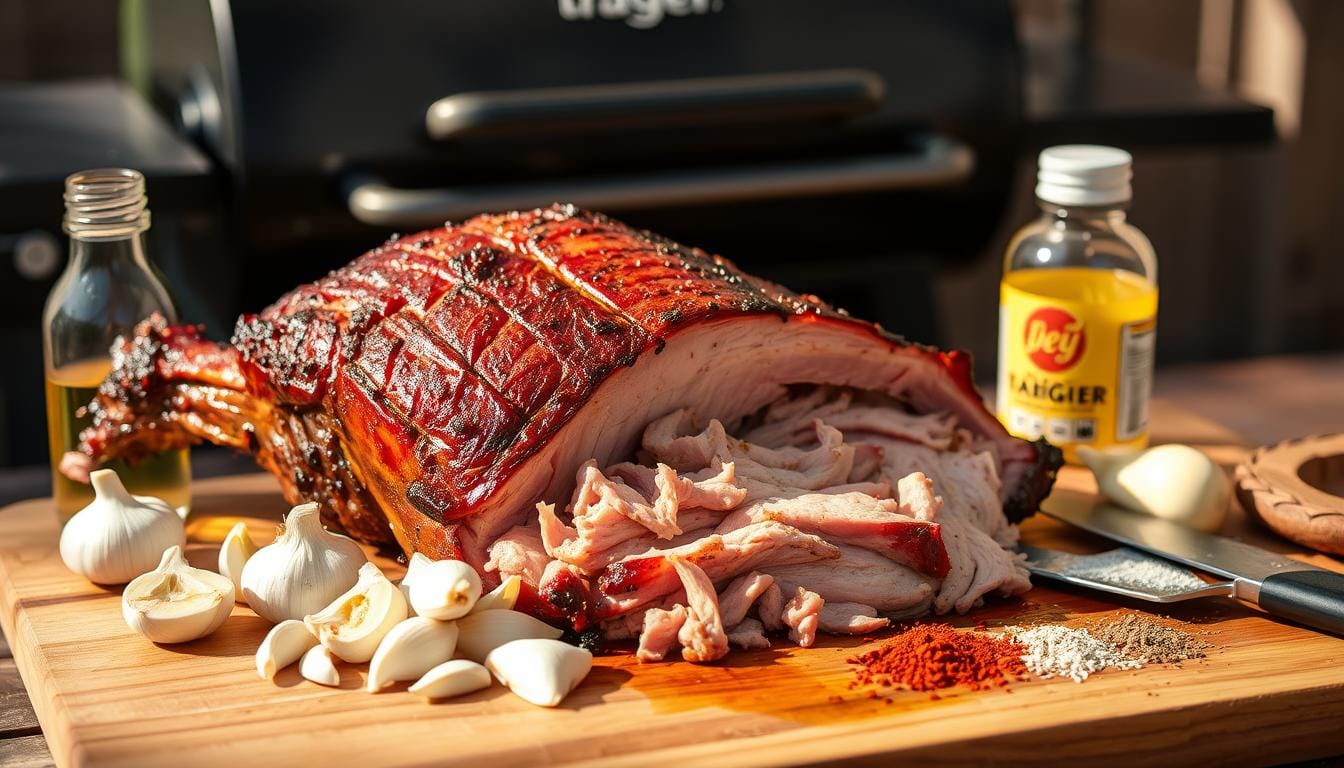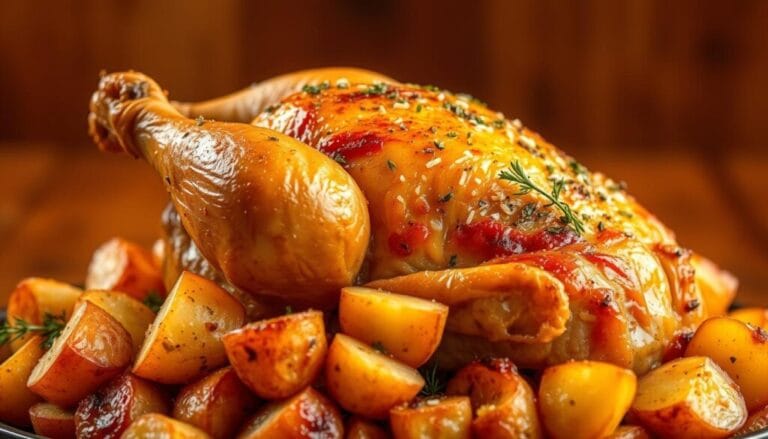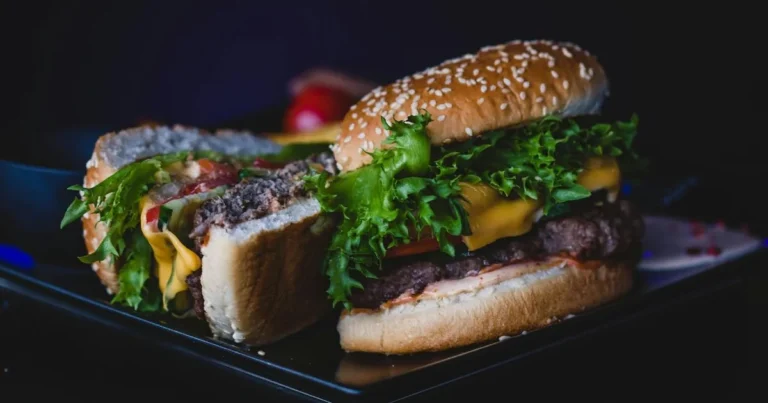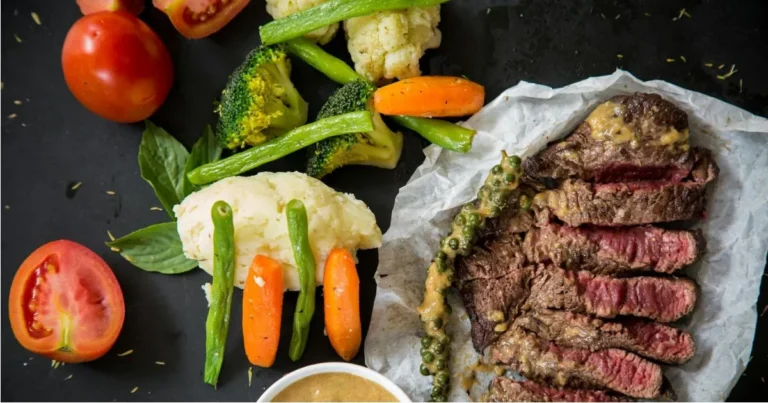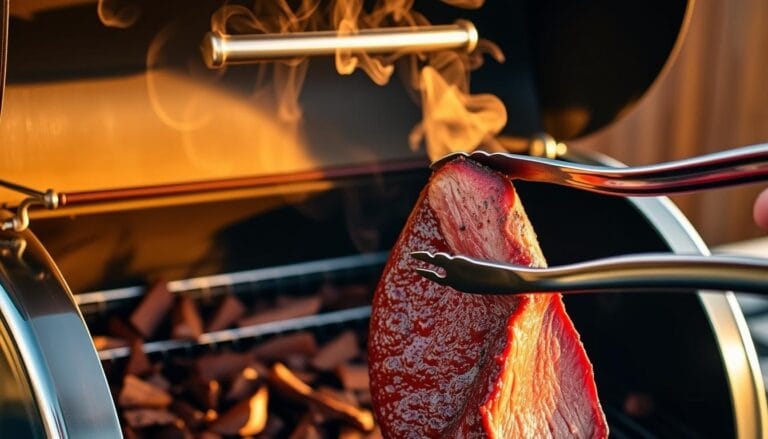Easy Juiciest Traeger Pulled Pork-7 Steps to Make
Table of Contents
Easy Juiciest Traeger Pulled Pork
Every pitmaster dreams of making the perfect smoked pulled pork. Your Traeger grill is about to become your secret weapon. I remember my first attempt at pellet grill pulled pork. It was a journey of patience, learning, and mouthwatering success.
Traeger pulled pork is more than a meal; it’s an experience. It combines precision cooking with incredible flavor. Whether you’re a backyard BBQ enthusiast or a serious smoker, these seven steps will guide you. You’ll create the most tender, juicy smoked pulled pork you’ve ever tasted.
The magic of Traeger pulled pork is in its ability to transform ordinary meat into a culinary masterpiece. With the right technique and patience, you’ll unlock flavors. Your friends and family will beg for your secret recipe.
Key Takeaways
- Master the art of smoking pork on a Traeger pellet grill
- Learn the precise temperature and timing for perfect pulled pork
- Understand the importance of meat selection and preparation
- Discover professional-level seasoning and smoking techniques
- Transform an ordinary pork butt into a mouthwatering meal
Why Choose Traeger for Pulled Pork?
Choosing the right grill is key to a great pulled pork experience. Traeger pellet grills change the game with their cooking precision and flavor. They offer something traditional grills can’t.
The Benefits of Pellet Grilling
Pellet grilling brings unique benefits for pulled pork. Traeger grills stand out because they:
- Keep a steady temperature
- Add authentic wood-fired taste
- Make temperature control easy
- Offer versatile cooking options
Flavor Complexity with Traeger
Traeger’s wood pellet technology adds depth to your pulled pork. Each pellet type brings a special smoky flavor. This turns simple meat into a gourmet dish.
| Wood Pellet Type | Flavor Profile | Best for Pulled Pork |
|---|---|---|
| Hickory | Strong, bacon-like | Classic BBQ taste |
| Apple | Sweet, mild | Subtle fruity notes |
| Mesquite | Intense, earthy | Bold flavor lovers |
Consistent Cooking Temperature
Keeping a steady temperature is vital for perfect pulled pork. Traeger grills hold a precise 250°F. This ensures your meat cooks evenly and reaches the perfect 205°F for tenderness.
“Precision is the key to extraordinary barbecue pulled pork.” – Traeger Grilling Expert
Ingredients You Will Need
Starting an amazing pork shoulder recipe means picking the right ingredients. Your journey to the best pulled pork recipe begins with knowing the key parts. These parts will turn a simple cut of meat into a delicious meal.
When making pulled pork, focus on three main things: the meat cut, spices, and smoking materials.
Pork Butt vs. Pork Shoulder: Understanding the Difference
Pork butt and pork shoulder are not the same, even though many think they are. For the best pulled pork, use an 8 to 10-pound pork butt. This cut is fattier, which makes the meat juicy and tender after smoking.
- Pork Butt: Fattier, more marbled cut
- Pork Shoulder: Leaner, slightly less tender
- Recommended weight: 8-10 pounds
- Ideal cooking time: 8-10 hours
Essential Spices and Rubs
A great dry rub can make your pork shoulder recipe amazing. Here’s a spice mix that will add incredible flavor:
- 2 1/2 teaspoons kosher salt
- 1/2 tablespoon brown sugar
- 2 1/4 teaspoons garlic powder
- 1/2 teaspoon paprika
- 1/2 teaspoon cumin
Wood Pellets for Smoking
Your choice of wood pellets greatly affects the taste. Hickory and apple wood pellets are great for pulled pork. They add rich, sweet smoky flavors that go well with the meat’s natural taste.
Picking the right ingredients is key to making a memorable pulled pork dish. It will surely impress your family and friends.
Preparing the Pork for Smoking
Creating tender pulled pork starts with proper preparation. Your journey to the most delicious juicy pulled pork begins right here. It starts with careful meat selection and treatment. The right techniques will transform an ordinary pork butt into a mouthwatering masterpiece.
Trimming the Meat
When preparing your pork butt, focus on strategic fat trimming. You’ll want to:
- Remove extremely thick fat layers
- Keep a thin fat cap (about 1/4 inch thick)
- Cut away any hard or discolored sections
Applying the Perfect Rub
A well-crafted rub is crucial for developing that incredible flavor in your juicy pulled pork. Consider this spice blend:
| Ingredient | Quantity |
|---|---|
| Kosher Salt | 2 1/2 teaspoons |
| Brown Sugar | 1/2 tablespoon |
| Garlic Powder | 2 1/4 teaspoons |
| Paprika | 1/2 teaspoon |
The Crucial Resting Period
After applying your rub, patience is key. Let your seasoned pork rest in the refrigerator for 2-24 hours. This waiting time allows the spices to penetrate deeply. It creates more tender pulled pork with intensified flavors.
Pro tip: Cover the meat loosely with plastic wrap during refrigeration. This prevents drying out while letting the rub work its magic.
Setting Up Your Traeger Grill
Getting your Traeger ready for pulled pork is all about the details. The right setup can greatly improve your pellet grill pulled pork. Before you start, it’s important to know the key steps for a delicious result.
Choosing the Right Temperature
Temperature control is key for pulled pork on a Traeger. Here are some important guidelines:
- Start with an initial temperature of 200°F
- Gradually increase to 250°F during cooking
- Aim for a target internal meat temperature of 160°F
- Final cooking temperature should reach 195°F-205°F
Preheating Your Grill
Proper preheating is crucial for even heat and consistent cooking. Follow these steps:
- Close the grill lid completely
- Preheat for exactly 15 minutes
- Verify the internal temperature is stable
- Check that all heating elements are functioning correctly
Adding Wood Pellets
Choosing the right wood pellets can make your pulled pork amazing. Here are some tips for selecting pellets:
- Choose hickory or oak for traditional BBQ flavor
- Apple or cherry wood pellets add a subtle sweetness
- Mix pellet types for complex flavor profiles
- Use high-quality, dry pellets for best results
Pro tip: Always store wood pellets in a dry place to maintain their quality and prevent moisture absorption.
The Smoking Process
Smoking pulled pork is an art that needs patience and precision. Your Traeger grill turns a simple pork butt into a delicious treat. It does this through a slow-cooked method that brings out amazing flavors and tenderness.
Timing Your Cook
Perfect smoked pulled pork comes from knowing cooking times and temperatures. A 9-pound pork butt cooks for about 14.5 hours. Here’s how the smoking timeline works:
- Initial smoking at 200°F for 12 hours
- Reach internal temperature of 160°F
- Wrap and increase temperature to 250°F
- Cook until internal temperature reaches 195°F
Basting Techniques for Moisture
Keeping your pulled pork moist is key. Basting prevents the meat from drying out during smoking. Use apple juice, beef broth, or a mix to spray or brush the meat.
The Wrap: When and Why to Wrap
Wrapping your pork butt is a crucial step. When the meat hits 160-170°F, wrapping helps get past the “stall” phase. It also keeps moisture in. Use aluminum foil or butcher paper for the best results.
| Smoking Stage | Temperature | Duration |
|---|---|---|
| Initial Smoking | 200°F | 12 hours |
| Wrapped Cooking | 250°F | 2-3 hours |
| Final Temperature Target | 195°F Internal | Until reached |
By sticking to these steps, you’ll make a delicious smoked pulled pork. It will wow even the pickiest barbecue fans.
Checking for Doneness
To get tender pulled pork, you need to know the right signs. Your Traeger grill journey ends when you know your pork is perfect.
Best Tools for Temperature Checks
Getting the temperature right is key for tender pulled pork. Use tools that give you accurate readings:
- Digital instant-read meat thermometer
- Wireless Bluetooth meat probe
- Infrared surface temperature gun
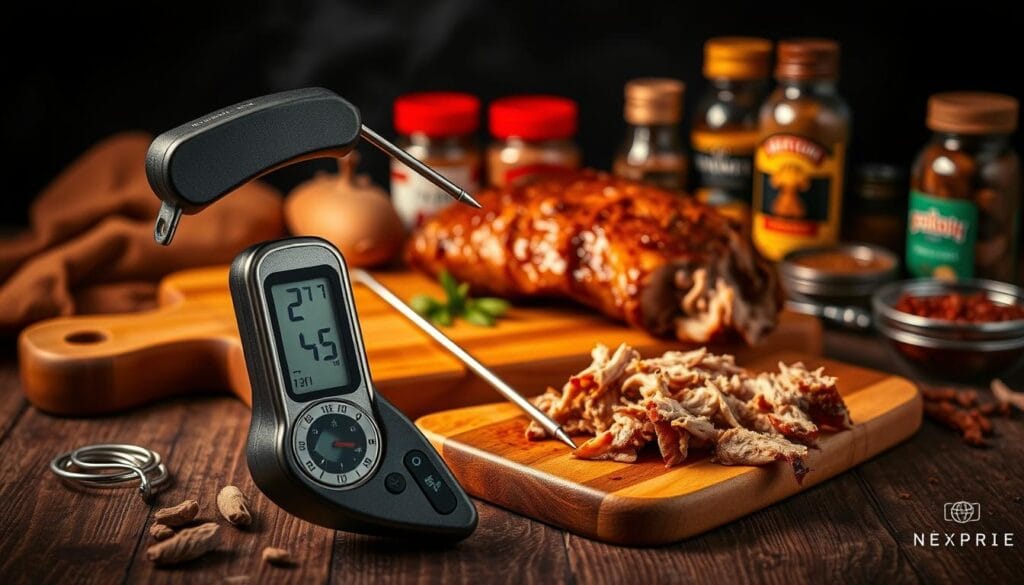
The Magic of the ‘Bark’
The bark is the tasty, crispy outside of smoked meat. Your pulled pork’s bark should be dark, crispy, and full of flavor. It forms when the meat hits 160°F, creating a caramelized layer that keeps moisture in.
Signs of Perfectly Cooked Pork
Knowing when your pulled pork is done involves several signs:
- Internal temperature between 195-205°F
- Meat easily pulls apart with minimal resistance
- Probe test: Thermometer slides in like butter
- Dark, mahogany-colored bark
Pro tip: Always let your meat rest 30-60 minutes after cooking to redistribute juices and enhance tenderness.
Mastering these techniques will help you make tender pulled pork that wows everyone.
Shredding the Pulled Pork
The final step in making the best pulled pork is shredding. How well you shred the meat affects the dish’s texture and taste. This step is key to a great barbecue pulled pork.
Essential Tools for Shredding
Choosing the right tools makes shredding easier. Here are the best ones:
- Meat claws (recommended for quick and efficient shredding)
- Two sturdy forks
- Disposable food-safe gloves
- Large cutting board
Professional Shredding Techniques
Follow these expert tips for shredding:
- Let the meat rest for 30-60 minutes after cooking
- Work against the meat’s grain
- Pull meat apart using consistent, gentle motions
- Keep pieces relatively uniform in size
Preventing Dry Pulled Pork
To keep the meat moist, remember these tips:
| Technique | Moisture Preservation Method |
|---|---|
| Resting | Allow 30-45 minutes for juice redistribution |
| Liquid Reintroduction | Drizzle reserved cooking juices while shredding |
| Temperature | Shred when meat is warm but not hot |
Pro tip: Always shred your pulled pork immediately before serving to ensure maximum tenderness and flavor in your best pulled pork recipe.
Serving Suggestions for Pulled Pork
Creating the best pulled pork recipe is just the start. Your perfectly smoked barbecue pulled pork needs a great presentation. This will impress your family and friends.
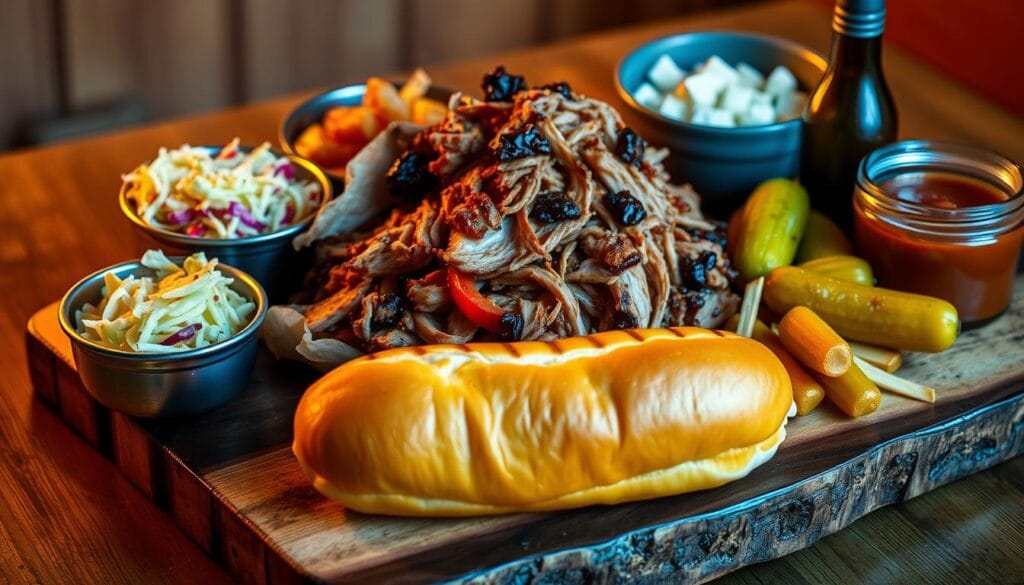
Choosing the Right Buns and Toppings
The key to a great pulled pork sandwich is the bun. Choose soft, slightly sweet brioche or classic potato rolls. They hold the tender meat well. Here are some tasty toppings:
- Creamy coleslaw
- Crispy pickles
- Tangy BBQ sauce
- Sliced jalapeños
- Caramelized onions
Perfect Sides to Pair with Pulled Pork
Pair your barbecue pulled pork with sides that boost the flavor. Here are some favorites:
| Side Dish | Flavor Profile |
|---|---|
| Baked Beans | Sweet and Smoky |
| Mac and Cheese | Creamy and Rich |
| Cornbread | Soft and Buttery |
| Potato Salad | Cool and Tangy |
Creative Uses for Leftovers
Don’t waste your delicious pulled pork! Turn leftovers into new meals:
- Pulled Pork Tacos
- Loaded Nachos
- Pulled Pork Pizza
- Stuffed Baked Potatoes
- Pulled Pork Quesadillas
Pro tip: Leftover pulled pork can be stored in an airtight container for up to 3 days. This way, you can enjoy your best pulled pork recipe again and again!
Storing and Reheating Pulled Pork
After making your tasty traeger pulled pork, it’s important to know how to store and reheat it. This way, you can enjoy your smoked pulled pork for days. Proper storage keeps the flavor and texture you worked so hard for.
Best Practices for Storage
Your smoked pulled pork can stay fresh in the fridge for 3-4 days. To keep it moist and flavorful, follow these tips:
- Cool the pulled pork completely before storing
- Use airtight containers or vacuum-sealed bags
- Store in shallow containers to help quick cooling
- Keep refrigerated at 40°F or below
Reheating Methods That Preserve Flavor
When reheating traeger pulled pork, warm it gently to avoid drying. Here are some good ways to do it:
- Oven Method: Preheat to 250°F, add a splash of broth or water, cover with foil, and heat for 30 minutes
- Microwave Method: Heat in 30-45 second intervals, stirring between each interval
- Slow Cooker: Warm on low with a bit of liquid for 2-3 hours
Freezing Pulled Pork for Later Use
You can freeze your smoked pulled pork for up to 3 months. Wrap it tightly in freezer-safe bags, removing as much air as possible. When you’re ready to eat it, thaw it in the fridge overnight. Then, reheat it using the methods mentioned above.
Final Thoughts on Traeger Pulled Pork
Your journey with pellet grill pulled pork doesn’t stop here. Mastering this recipe opens a world of possibilities with your Traeger grill. Every smoke session will make you more confident and skilled in making tasty dishes.
Traeger grills are versatile, not just for pulled pork. You can try smoking brisket, ribs, chicken, and even pizzas and desserts. The wood-fired flavor and precise temperature control make every dish unique and delicious.
Enjoying What You’ve Created
Barbecue is more than cooking; it’s about making memories. Your pulled pork is the result of patience, technique, and passion. Enjoy each bite, knowing you’ve made something special with your Traeger and skills.
Sharing the Experience with Friends
Sharing great food makes it even better. Invite friends and family to try your smoked pulled pork. With 14 servings, there’s plenty to share. See their amazement at the tender, flavorful meat that shows off your barbecue skills.
Exploring Other Recipes on Your Traeger
This pulled pork recipe is just the start of your Traeger adventure. Every recipe you try will improve your skills and expand your cooking range. Keep trying new things, stay curious, and enjoy the tasty journey of pellet grill cooking.

